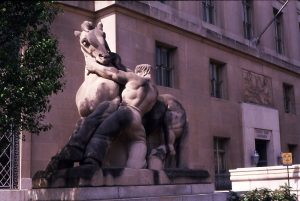Author: Steven J. Cernak
Recently, I was researching 2021 antitrust developments to update my Antitrust in Distribution and Franchising book and draft a long article for another publication. That research confirmed that new government antitrust enforcers and their actions gathered the most attention last year — but this blog covered those issues already, such as here and here and here. This post discusses the private antitrust litigation developments affecting distribution that I uncovered but that might have flown under your radar.
Refusal to Deal and Predatory Pricing
Despite the impression left by the mainstream media, not all antitrust cases involving claims of monopolization involved Amazon or Facebook. Other defendants faced claims of gaining or maintaining a monopoly through refusals to deal or predatory pricing schemes.
Careful readers will recall the anticipation last year that Viamedia Inc. v. Comcast Corp. might generate a Supreme Court opinion on refusal to deal issues. Here, the defendant monopolist had stopped dealing with the plaintiff after years of doing so and, allegedly, caused competitive harm. The district court had dismissed the refusal to deal claim by explicitly following the Tenth Circuit’s opinion in Novell, Inc. v. Microsoft Corp., authored by then-Judge Gorsuch, because it found that the defendant’s conduct was not “irrational but for its anticompetitive effect.” The Seventh Circuit reversed, finding the court’s application of the Novell standard inappropriate at the motion to dismiss stage when a plaintiff need only plausibly allege anticompetitive conduct even if the defendant might later try to prove a procompetitive rationale.
The defendant sought Supreme Court review and the Justices asked for the views of the Solicitor General. The Solicitor General did not recommend that the Court hear the appeal. In June, the Court denied the writ of certiorari. After remand, the plaintiff chose to drop its refusal to deal theory of the case and proceed only on a claim of illegal tying. Therefore, the opinion will stand and future monopolist defendants, at least in the Seventh Circuit, will have more difficulty dismissing refusal-to-deal claims. Instead of simply asserting that some rational potential procompetitive purpose or effect is self-evident from the complaint, the defendant will have to show that the allegations do not raise any plausible anticompetitive purpose or effect, a much more difficult burden.
In another refusal to deal case, OJ Commerce LLC v. KidKraft, LP, the defendant won summary judgment on plaintiff’s refusal-to-deal claim. Plaintiff was a discounting online retailer that had sold defendant’s products, including children’s wooden play kitchens, for years. An affiliate of plaintiff then began making wooden play kitchens that plaintiff also sold on its website. Defendant objected, claiming that the affiliates’ kitchens were knock-offs of defendant’s products and that plaintiff’s sales of defendant’s products were plummeting. Eventually, defendant terminated its relationship with plaintiff, who then sued alleging illegal monopolization through a refusal to deal.
The court began with the proposition that even a monopolist is not required to do business with a rival. The court recognized that the Supreme Court had found an exception to that proposition in Aspen Skiing Co. but only if defendant’s termination of prior conduct was irrational but for its anticompetitive effect. The court found “this is hardly the case here” as the defendant had shown several other potential explanations for its termination of plaintiff. As a result, the court granted defendant’s summary judgment motion.
Predatory pricing remains a popular claim by plaintiffs against alleged monopolists, despite the difficult standard for such claims imposed by the Supreme Court. In such claims, the plaintiff alleges that the defendant’s extraordinarily low prices will drive out competitors, which in turn will allow the defendant to later raise prices and harm consumers. In Brooke Group, the Court set a difficult standard to meet because “there is a consensus among commentators that predatory pricing schemes are rarely tried, and even more rarely successful.” Also, it can be difficult to distinguish low pro-competitive prices from predatorily low ones. Subsequent plaintiffs have found it difficult to successfully allege, let alone win, such claims.
Last year, we described an exception where a defunct ride-hailing company’s predatory pricing claims against Uber survived a motion to dismiss. In 2021, a taxi company was not as successful and its similar claims were dismissed (although other non-antitrust claims survived). In Desoto Cab Co. v. Uber Technologies, Inc., the court dismissed the claim because the plaintiff did not allege barriers to entry or expansion for new or existing competitors sufficient to allow defendant to recoup its losses. Plaintiff’s mere invocation of network effects without any allegations regarding how they might create entry barriers in this market also was not enough. Finally, unlike the plaintiff in last year’s case, this plaintiff failed to allege why Lyft no longer could prevent defendant’s recoupment through higher prices.
Tying and Agreement
2021 also brought opinions on some of the basic elements of a tying claim and what facts amounted to an agreement.
One element of a successful tying claim is that the defendant is selling two separate products, the tying and the tied product. To make that determination, courts must find that “there is a sufficient demand for the purchase of [the tied product] separate from [the tying product] to identify a distinct product market in which it is efficient to offer [the former] separately from [the latter].” In AngioDynamics, Inc. v. C.R. Bard, Inc., the court denied competing summary judgment motions from the parties on this question. The defendant had sought and received regulatory approval to sell the tied product separately; however, it had actually made only a few such sales and then just to a single customer. The only other competitor that sold both products did sell them separately; however, it was not clear that its conditions were identical to defendant’s. The court, therefore, could not determine as a matter of law that the consumer demand was sufficient to make it efficient for defendant to offer the tied product separately.
For every Sherman Act Section 1 case, a successful plaintiff must show an agreement between defendant and some other entity. To meet that burden at summary judgment or trial, plaintiff must present “evidence that tends to exclude the possibility that the [the defendants] were acting independently.” In a typical distribution case, a terminated distributor claims an anticompetitive agreement between its supplier and some other distributor, usually based on some complaints about the terminated distributor to the supplier from the other distributor.
 The Antitrust Attorney Blog
The Antitrust Attorney Blog












